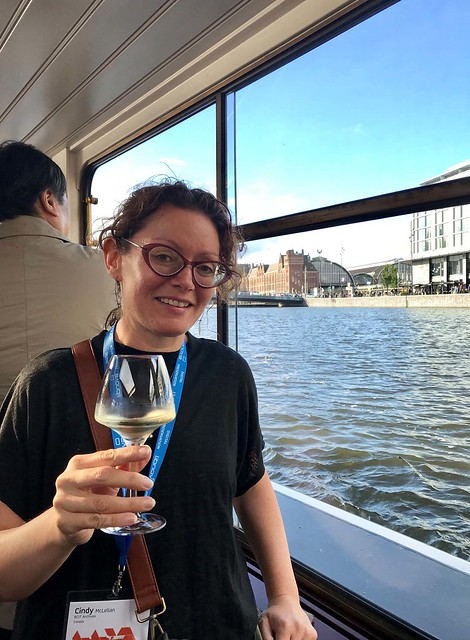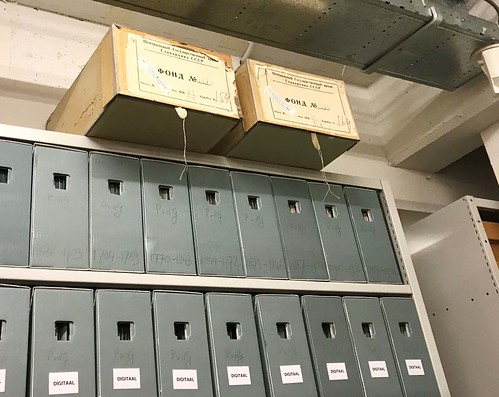Photo from the ferry of the Eye Film Museum. Photograph by C. McLellan
iPres took place at the Eye Film Museum. An eye-catching building that is a free 5 minute ferry ride from Amsterdam Centraal. It was a jam-packed five days often with four concurrent sessions; making choices about which room to be in difficult.
After I left Amsterdam someone tweeted about this art project to the #iPres2019 hashtag. Faces on the ferry by Rachelle Meyer. Her work sparked some happiness in me. The bike culture in Amsterdam is captured very well on these ferries and by Meyer. Each drawing is a mini story about someone going somewhere. The theme of commuting in the different seasons comes through really nicely in the titles and what the subjects are wearing.
I have been consciously thinking about the power of story-telling in my Archival practice lately. The stories waiting to be found in Archives and the stories we tell about our holdings have the power to inspire, to provide proof, to make a connection with the past and so much more. Stories can be used to demonstrate the value of Archives which Archivists are asked to do more than we’d like. Stories are great for helping the uninitiated understand the importance of long term digital preservation.
One of my thirty-second digital preservation pitches is about VHS tapes and the fact that the last VCR was manufactured in 2017. Enthusiasts like to think that parts for old machines could be 3D printed; there’s going to be a limit to how long old machines can be kept in working order. Adding to this problem, the tapes themselves have moving parts that wear, never mind the delicate nature of the magnetic tape itself.
Each of the three wonderful keynotes at iPres told at least one story. The stories that resonate, for me, are grounded in truth and contain at least a nod to humour. So I am going to center my post around storytelling.
The conference began with a keynote from Geert Lovink a media theorist from the Institute of Network Cultures (INC). INC does applied Science and Lovink’s research about the internet and has been active since the 1990s. The model of the INC is based on a sustained interrelationship between public research, publications and events. Lovink and INC strongly believe that meeting in person in a physical space is vital to richness and diversity and maintaining meaningful networks. INC is involved in many networks that critically engage with internet culture.
The story Lovink told was about his teenage son, his most intimate informant. Being a person who has been thinking critically about the internet since the 1990s Lovink looks to his son as someone with their finger on the pulse of the internet. And it was his son who convinced him of the necessity and relevance of his latest area of inquiry: Sadness. The interaction that sparked a focus on sadness was a sincere conviction from his son that everything is sad. The water glass on the table is sad. Sadness is everywhere. Social Media creates and reinforces sadness. The immediacy of what one’s friends are doing online – constant updates require constant attention. He argues that the internet has stagnated and regressed there is a monopoly by a few Social Media platforms over the online experience of the majority of internet users. After reading from his newest book: Sad by design: On platform nihilism Lovink did not leave us completely sad. He pointed to the website Humane Tech. If was started by former Google and Facebook employees/dissidents that want to understand how the Social Media behavioral modifications can be reversed. And how societies and young people can learn to break free from platform monopolies.
Excellent way to travel to a conference dinner in Amsterdam. Photograph by H. Mackay
Michelle Caswell delivered the second excellent keynote. Her introductory story stemmed from the feminist standpoint epistemology of valuing knowledge gained from lived experience. The fact that in the early 1990s she was attending Columbia University in NY was surprising given that she: is a white American woman, who was public school educated, accustomed to being one of the few white women in her predominantly black Chicago high school, and neither of her parents graduated from high school; her working class background made it obvious to her that she did not belong. However, although she felt alienated acutely, her not belonging was invisible to others because of her whiteness. The required freshmen Contemporary Civilizations class reading list had remained unchanged at Columbia since 1919 and included only classics written by white men for white men of priviledge. Caswell’s classmates knew these texts; they had read them before, at their private high schools, possibly in the original Greek or Latin, and were comfortable preforming, for four years, what was expected of them at university before they inherited the earth from their families. Caswell had a difficult time seeing herself in the readings and eventually vented her frustration in an essay about how she did not belong instead of the assigned weekly reaction to the reading. Luckily for her, her professor took her for coffee after class and pushed her in the direction of post-colonial studies where she found some critical thinkers who made sense to her own world view.
With this framing she challenged us, the digital archivists in the room, to look at our work in a new way. Archivists are obsessed with context and the context in which records are created and used. Archivists do not often look at the broader context of the existing dominant power; often, our employer, e.g. a government – which is not neutral. She points out the myth of neutrality and argues that dominate archival practices and theories, written by white men working for governments, are oppressive by design. Archivists are not neutral and the archives in their care are also not neutral. Let’s start valuing ways of being from the margins and create collecting policies for our archives that are socially located and culturally situated not solely from the unquestioned place of power (we know lots about them and so will future researchers). If you are interested in archival theory and want to start asking more questions in your archives do read more about Caswell’s Feminist Standpoint Appraisal.
Favourite quote: Feminism is for everybody. Patriarchy hurts us all: just not equally.
This is a warm stroopwaffle with chocolate. Highly recommended. Photograph by C. McLellan
Once upon a time there were some mice who thought it would be great if the cat that terrorized them wore a bell. Then they would be able to hear the cat coming. Some brave mice banded together and put a bell on the cat. A version of this story was used to introduce Eliot Higgins of Bellingcat.
The room remained quiet while Higgins told us about how he and Bellingcat have been using their networks and tools available on the internet to determine truth from lies. Their main focus has been discovering truth from lies when it comes to war. Using Google maps and other tools to determine whether what was bombed was, as claimed, a legitimate military target or a hospital or a school or a residential area. Using their extensive network and tools online they have aided police in uncovering the location of illegal activities.
One of the stories that resonated with everyone was about how Bellingcat showed that the Russian Ministry of Defense used footage from a videogame to ‘prove’ that the US Military was working with ISIS to promote American interests in the Middle East. Bellingcat was so successful showing the Russian military using something as ridiculous as a videogame as irrefutable evidence that even mainstream Russian media picked the story up.
Story after story Bellingcat was succeeding in revealing the truth. In the current state of the world it is very important work indeed. Check out Bellingcat’s Yemen project.
All three keynotes were excellent and told stories worth listening to. Links to those stories can be found here:
- Keynote 1: Geert Lovink, Institute of Network Culture. Sad by Design: Politics and Psychology of the Social Media Age
- Keynote 2: Michelle Caswell, University of California at Los Angeles. Whose Digital Preservation? Locating our standpoints to reallocate resources
- Keynote 3: Eliot Higgins, Bellingcat. Bellingcat and beyond. The future for Bellingcat and online open source investigation
As of December 9, 2019 the conference proceedings were made available both on the Phaidra Repository, and the Open Science Framework (OSF) for scholarly documentation where you can also access all posters, hack-a-thon materials, tutorials, etc..
I got a behind-the-scenes tour of Atria Institute on gender equality and women’s history. It was was the first women’s rights archives in Europe as it started in 1939. Those boxes at the top are a sample of the boxes that material was returned to the Atria Archives from Russia in the early 1990s. The materials were stolen by the Nazis. Photograph by C. McLellan



